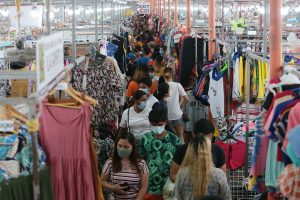




Philippines Trade Update: Trade trajectories trend along
 DOWNLOAD
DOWNLOAD

Policy Rate Updates: Double cut finale
 DOWNLOAD
DOWNLOAD

Monthly Economic Update: One for the road
 DOWNLOAD
DOWNLOAD


Philippine consumption likely to slow this year

CONSUMPTION in the Philippines will likely slow down the most among Southeast Asian countries this year, as households struggle with rising prices and interest rates, HSBC Global Research said.
In a note on Thursday, HSBC said inflation remains a key concern among consumers as most policy makers in the Association of Southeast Asian Nations (ASEAN) member countries are unlikely to implement consumer-friendly measures in battling inflation.
“We think consumption in ASEAN will slow in 2023 but in varying degrees; consumption in the Philippines will likely slow down the most, while Vietnam, Malaysia and Singapore may show some resilience,” HSBC said.
HSBC noted the Philippines saw the prices of goods and services rise faster than wages in 2022, which eroded purchasing power and may curb consumption in the near future.
“Inflation usually works with a lag and households will likely continue to readjust their expenditure throughout the year in consideration of the steep rise in the cost of living,” HSBC said.
Inflation remained elevated in the Philippines, averaging 5.6% in 2022. In January, headline inflation further accelerated to 8.7% from 8.1% in December, in contrast to downward trend in most ASEAN countries.
“Fortunately, most ASEAN economies passed the peak of inflation, though the Philippines and Vietnam have continued to see intensifying price pressures,” HSBC added.
The Bangko Sentral ng Pilipinas (BSP) revised its annual average inflation forecast to 6.1% this year from 4.5% previously.
“The Philippines saw the purchasing power of its wages decline significantly, wherein the rise in the cost of living almost doubled compared to the rise in wages. This deterioration will likely take a toll on consumption in 2023 as households find their way around to make ends meet amid the squeeze in household budgets,” HSBC said.
This year, HSBC noted central banks in ASEAN may continue to hike rates to curb demand-driven inflation.
“The Philippines and Thailand will likely take the biggest hit as their central banks are taking a relatively hawkish stance to bring the economy-wide saving rate back up, striking a balance between consumption and macroeconomic stability,” it said.
HSBC expects the BSP to raise rates as high as 250 basis points (bps) above pre-pandemic levels, which may hurt borrowing and consumption.
The benchmark interest rate stood at 4% in 2019 before the Monetary Board cut rates by 200 bps in 2020 to support the pandemic-hit economy. Since May 2022, the BSP has raised rates by 400 bps to curb inflation.
“High interest rates will deter consumers from borrowing, while it promotes saving since interest income from savings increases. Given this dynamic, the Philippines and Thailand will likely see the largest adjustment in economy-wide savings,” it said.
Domestic consumption remained strong as the economy reopened. It expanded by 7% in the fourth quarter, slightly slower than 8% in the third quarter and 7.5% a year earlier. For the full year, household consumption rose by 8.3% from a year earlier.
“All data point to the Philippines slowing down the most — not favorable news for an economy so driven by private consumption. Nonetheless, its fundamentals too should help smooth household consumption or at least put a floor on how much it could slow,” HSBC said.
“For instance, the Philippines has one of the most favorable demographic profiles. The fertility rate in the Philippines is the highest in ASEAN at 2.7, while the median age is only 25 years. Therefore, consumption will likely slow but not free-fall due to a rising working age population,” it said.
HSBC also said remittances can help smooth out incomes and consumption to some extent, and money sent home to the Philippine rise during hard times.
Money sent by OFWs through banks jumped by 3.6% to USD 32.54 billion last year, according to data released by the BSP. It exceeded the previous record of USD 31.42 billion in 2021. — Keisha B. Ta-asan
This article originally appeared on bworldonline.com





 By BusinessWorld
By BusinessWorld